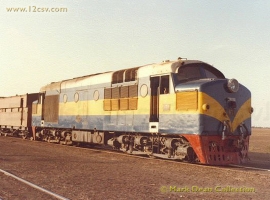1000 Class
Missing Details
Date to be confirmed
© Mark Dean
- Overview
- Status
- Equipment
- Specifications
- History
- Photographs
Introduced |
1960-1969 |
|---|---|
Manufacturer |
English Electric Co. Ltd, Vulcan Foundry, Newton-le-Willows, Merseyside Robert Stephenson & Hawthorn, Darlington Works, Darlington, County Durham. |
Running Numbers |
1000-1064 |
Number Built |
65 |
Note(s) |
|
|---|---|
* |
Details of these locomotives is very scarce, but it is believed that many have been dismantled in recent years, although one was destined for the railway museum at Atbara. |
| Status | Total |
|---|---|
| Scrapped | 65 |
1000, 1001, 1002, 1003, 1004, 1005, 1006, 1007, 1008, 1009, 1010, 1011, 1012, 1013, 1014, 1015, 1016, 1017, 1018, 1019, 1020, 1021, 1022, 1023, 1024, 1025, 1026, 1027, 1028, 1029, 1030, 1031, 1032, 1033, 1034, 1035, 1036, 1037, 1038, 1039, 1040, 1041, 1042, 1043, 1044, 1045, 1046, 1047, 1048, 1049, 1050, 1051, 1052, 1053, 1054, 1055, 1056, 1057, 1058, 1059, 1060, 1061, 1062, 1063, 1064. |
|
Total |
65 |
Engine |
English Electric 12CSVT MKII |
|---|---|
Main Generator |
English Electric 822/16J |
Auxiliary Generator |
English Electric 755 |
Traction Motors |
English Electric 537 x 6 |
Locomotive Brakes |
Vacuum, Rheostatic |
Train Brakes |
Vacuum |
Wheel Arrangement |
Co-Co |
| Imperial | Metric | |
|---|---|---|
Gauge |
3ft 6in |
1067 mm |
Minimum Curve |
264 ft 0 in |
80467 mm |
Length |
55 ft 0 in |
16764 mm |
Width |
9 ft 9 in |
2972 mm |
Height |
13 ft 5 in |
4089 mm |
Weight |
97 1/2 tons |
99 tonnes |
Fuel Capacity |
1000 Gallons |
4545 litres |
Power Rating |
2025 / 1840 HP |
1511/1373 kW |
Tractive Effort (Start) |
55,000 lbs |
253 kN |
Tractive Effort (Cont) |
48,000 lbs at 11 1/2 mph |
221 kN at 18.4km/h |
Speed |
45 mph |
73 km/h |
Information concerning any class of locomotive that has been built for the Sudan Government Railways has always been vague, this includes the '1000 class' which were built by English Electric, and were actually the first locomotives to be fitted with the 12CSVT Diesel engine.
The initial order for 12CSVT fitted locomotives was made by the 'East African Railways & Harbours' for what was to become the '90 class', but due to the urgent need for locomotives in Sudan, with British government help, English Electric were approached during 1958 with the request to design and produce locomotives in a shorter period of time than was usually expected. To enable this quick turn around, the company pulled in resources from other projects on the go at the time and by early 1959 the plans were in place to begin construction, for which the company had to find space in an almost full production line.
From English Electric records, the first 15 locomotives of 1000 class were built at the Vulcan Foundry during late 1959, with the initial order for the 'EAR&H' 90 Class locomotives being 'contracted out' to the Darlington Works of Robert Stephenson & Hawthorn to make room, and these were exported by sea to the Sudan in 1960. They were so successful that further orders for locomotives of the same design were received in 1961, 1964 and 1969, with all 65 members of the class being constructed at Newton-le-Willows.
Towards the end of the 1980's it was reported that all 65 locomotives were still in use, which seems unlikely due to the economic climate at the time, but there was definitely a small number of locomotives in use.
By the end of the 20th century, information on the locomotives was still very rare, and realistically by then all the locomotives were likely to have been out of use, or perhaps scrapped. Evidence of the scrapping of some locomotives was unearthed in 2010, so for the sake of this site, all locomotives are now thought to have been scrapped unless any evidence comes to light that proves otherwise.
If you can perhaps provide some information, or photographs, for the Sudanese '1000 class', please get in touch using this contact form.














